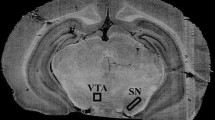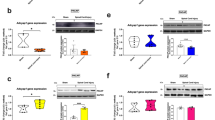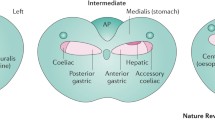Abstract
It has been previously shown that withdrawal from alcohol decreases the synthesis and expression of vasopressin (VP) and vasoactive intestinal polypeptide (VIP) in the suprachiasmatic nucleus (SCN), and that the infusion of NGF over 1 month completely restores these changes. Because SCN neurons do not express TrkA, NGF might have exerted its effects either through direct signalling of the neurons via p75NTR or by enhancing the activity of the cholinergic afferents to the SCN, which arise from the nucleus basalis magnocellularis (NBM). The observation that the infusion of NT-3 to withdrawn rats does not elicit any change in neuropeptide expression in the SCN suggests that ACh might be implicated in this process, a hypothesis that we have attempted to clarify in this study. For this purpose we destroyed, with quinolinic acid, the NBM of rats withdrawn from ethanol and later infused them with NGF over a period of 13 days. The total number and the somatic volume of SCN neurons immunoreactive for VP and VIP were stereologically estimated. No differences were found in the total number of neurons between quinolinic-injected NGF-treated withdrawn animals and intact withdrawn rats. However, the somatic volume of SCN neurons from quinolinic-injected animals was significantly reduced relative to control and withdrawn rats. The present results unequivocally demonstrate that the trophic effects exerted by NGF upon SCN neurons do not depend on direct neuronal signalling. Instead, they are indirect and, according to our results, NBM neurons, whose axons give rise to a cholinergic projection to the SCN, seem to be essential for eliciting those effects.
Similar content being viewed by others
References
Alfonso, M., DurÁn, R. & MarcÓ, J. (1993) Ethanol-induced alterations in gonadotrophins secretion during the estrous cycle of rats. Alcohol and Alcoholism 28, 667–674.
Aloe, L. &Tirassa, P. (1992) The effect of long-term alcohol intake on brain NGF-target cells of aged rats. Alcohol 9, 299–304.
Aloe, L., Bracci-Laudiero, L. & Tirassa, P. (1993) The effect of chronic ethanol intake on brain NGF level and on NGF-target tissues of adult mice. Drug and Alcohol Dependence 31, 159–167.
Anderson, K. D., Alderson, R. F., Altar, C. A., Distefano, P. S., Corcoran, T. L., Lindsay, R. M. & Wiegand, S. J. (1995) Differential distribution of exogenous BDNF, NGF, and NT-3 in the brain corresponds to the relative abundance and distribution of high-affinity and low-affinity neurotrophin receptors. Journal of Comparative Neurology 357, 296–317.
Arendt, T., Hennig, D., Gray, J. A. & Marchbanks, R. M. (1988) Loss of neurons in the rat basal forebrain cholinergic projection system after prolonged intake of ethanol. Brain Research Bulletin 21, 563–570.
Beal, M. F., Kowall, N. W., Ellison, D. W., Mazurek, M. F., Swartz, K. J. & Martin, J. B. (1986) Replication of the neurochemical characteristics of Huntington's disease by quinolinic acid. Nature 321, 168–171.
Beal, M. F., Kowall, N. W., Swart, K. J., Ferrante, R. J. & Martin, J. B. (1988) Systemic approaches to modifying quinolinic acid striatal lesions in rats. Journal of Neuroscience 8, 3901–3908.
Bina, K. G. & Rusak, B. (1996) Nerve growth factor phase shifts circadian activity rhythms in Syrian hamsters. Neu-roscience Letters 206,97–100.
Bina, K. G., Rusak, B. & Semba, K. (1993) Localization of cholinergic neurons in the forebrain and brainstem that project to the suprachiasmatic nucleus of the hypothalamus in rat. Journal of Comparative Neurology 335, 295–307.
Bina, K. G., Rusak, B. & Semba, K. (1997) Sources of p75-nerve growth factor receptor-like immunoreactivity in the rat suprachiasmatic nucleus. Neuroscience 77, 461–472.
Cadete-Leite, A., Pereira, P. A., Madeira, M. D. & Paula-Barbosa, M. M. (2003) Nerve growth factor prevents cell death and induces hypertrophy of the basal forebrain cholinergic neurons in rats withdrawn from prolonged ethanol intake. Neuroscience 119, 1055–1069.
Carnahan, J. & Nawa, H. (1995) Regulation of neuropeptide expression in the brain by neurotrophins. Potential role in vivo. Molecular Neurobiology 10, 135–149.
Carter, B. D., Kaltschmidt, C., Kaltschmidt, B., OffenhÄuser, N., BÖ hm-Matthaei, R., Baeuerle, P. A. & Bard, Y.-A. (1996) Selective activation of NF-kB by nerve growth factor through the neurotrophin receptor p75. Science 272, 542–545.
Chao, M. V. & Hempstead, B. L. (1995) p75 and Trk: A two-receptor system. Trends in Neurosciences 18, 321–326.
Colwell, C. S., Kaufman, C. M. & Menaker, M. (1993) Phase-shifting mechanism in the mammalian circadian system: New light on the carbachol paradox. Journal of Neuroscience 13, 1454–1459.
Croll, S. D., Wiegand, S. J., Anderson, K. D., Lindsay, R. M. & Nawa, H. (1994) Regulation of neuropeptides in adult rat forebrain by the neurotrophins BDNF and NGF. European Journal of Neuroscience 6, 1343–1353.
Deimling, M. J. & Schnell, R. C. (1980) Circadian rhythms in the biological response and disposition of ethanol in the mouse. Journal of Pharmacology and Experimental Therapeutics 213,1–8.
De Witt, P. (1996) The role of neurotransmitters in alcohol dependence: Animal research. Alcohol and Alcoholism 31, 13–16.
Ehlers, M. D., Kaplan, D. R., Price, D. L. & Koliatsos, V. E. (1985) NGF-stimulated retrograde transport of trkA in the mammalian nervous system. Journal of Cell Biology 130, 149–156.
Gibbs, R. B. & Pfaff, D. W. (1994) In situ hybridization detection of trkA mRNA in brain: Distribution, colocalization with p75NGFR and up-regulation by nerve growth factor. Journal of Comparative Neurology 341, 324–339.
Giordano, M., Ford, L. M., Brauckmann, J. L., Norman, A. B. & Sanberg, P. R. (1990) MK801 prevents quinolinic acid-induced behavioural deficits and neurotoxicity in the striatum. Brain Research Bulletin 24, 313–319.
Gritti, I., Mainville, L. & Jones, B. E. (1993) Codistribution of GABA-with acetylcholine-synthesizing neurons in the basal forebrain of the rat. Journal of Comparative Neurology 329, 438–457.
Gundersen, H. J. G. & Jensen, E. B. (1987) The efficiency of systematic sampling in stereology and its prediction. Journal of Microscopy 147, 29–63.
Gundersen, H. J. G., Jensen, E. B. V., KiÊu, K. & Nielsen, J. (1999) The efficiency of systematic sampling in stereology, reconsidered. Journal of Microscopy 193, 199–211.
Hassink, G. C., Van Esseveldt, K. E., Dijkhvizen, P. A., Verhaagen, J. & Boer, G. J. (1999) Ontogeny of neurotrophin receptor trkC expression in the rat forebrain and anterior hypothalamus with emphasis on the suprachiasmatic nucleus. Neuroscience 92, 705–712.
Heaton, M. B., Kim, D. S. & Paiva, M. (2000) Neurotrophic factor protection against ethanol toxicity in rat cerebellar granule cell cultures requires phosphatidylinositol 3-kinase activation. Neuroscience Letters 291, 121–125.
Heaton, M. B., Paiva, M., Swanson, D. J. & Walker, D. W. (1993) Modulation of ethanol neurotoxicity by nerve growth factor. Brain Research 620, 78–85.
Heaton, M. B., Paiva, M., Swanson, D. J. & Walker, D. W. (1994) Responsiveness of cultured septal and hippocampal neurons to ethanol and neurotrophic substances. Journal of Neuroscience Research 39, 305–318.
Hu, L., CÔTÉ, S. L. & CUELLO, A. C. (1997) Differential modulation of the cholinergic phenotype of the nucleus basalis magnocellularis neurons by applying NGF at the cell body or cortical terminal fields. Experimental Neurology 143, 162–171.
Jarvis, C. R., Xiong, Z. G., Plant, J. R., Churchil, D., Lu, W. Y., Macvicar, B. A. & Macdonald, J. F. (1997) Neurotrophin modulation of NMDA receptors in cultured murine and isolated rat neurons. Journal of Neurophysiology 78, 2363–2371.
Kiss, J. & HalÁsz, B. (1996) Synaptic contacts between cholinergic afferents and suprachiasmatic neurons of the rat. NeuroReport 7, 1961–1964.
Kiss, J., Patel, A. J. & HalÁsz, B. (1993) Colocalization of NGF receptor with VIP in rat suprachiasmatic neurones. NeuroReport 4, 1315–1318.
Koliatsos, V. E., Price, D. L., Gouras, G. K., Cayouette, M. H., Burton, L. E. & Winslow, J. W. (1994) Highly selective effects of nerve growth factor, brain-derived neurotrophic factor, and neurotrophin-3 on intact and injured basal forebrain magnocellular neurons. Journal of Comparative Neurology 343, 247–262.
Kume, T., Nishikawa, H., Tomioka, H., Katsuki, H., Akaike, A., Kaneko, S., Maeda, T., Kihara, T. & Shimohama, S. (2000) p75-mediated neuroprotection by NGF against glutamate cytotoxicity in cortical cultures. Brain Research 852, 279–289.
Lehman, M. N., Jansen, H. T., Wortman, M., Stevens, P., Kim, C., Norgren, R. B. & Zeitler, P. (1996) Neurotrophin and neurotrophin receptor expression in the suprachiasmatic nucleus (SCN) of rats and hamsters. Society for Neuroscience Abstracts 22, 1141.
Lessmann, V. (1998) Neurotrophin-dependent modulation of glutamatergic synaptic transmission in the mammalian CNS. General Pharmacology 31, 667–674.
Lindsay, R. M. & Harmar, A. J. (1989) Nerve growth factor regulates expression of neuropeptide genes in adult sensory neurons. Nature 337, 362–364.
Liu, C. & Gillette, M. U. (1996) Cholinergic regulation of the suprachiasmatic nucleus circadian rhythm via a muscarinic mechanism at night. Journal of Neuroscience 16, 744–751.
Lovinger, D. M. (1993) Excitotoxicity and alcohol-related brain damage. Alcoholism: Clinical and Experimental Research 17, 19–27.
Madeira, M. D. & Paula-Barbosa, M. M. (1999) Effects of alcohol on the synthesis and expression of hypothalamic peptides. Brain Research Bulletin 48, 3–22.
Madeira, M. D., Andrade, J. P., Lieberman, A. R., Sousa, N., Almeida, O. F. X. & Paula-Barbosa, M. M. (1997) Chronic alcohol consumption and withdrawal do not induce cell death in the suprachiasmatic nucleus, but lead to irreversible depression of peptide immunoreactivity and mRNA levels. Journal of Neuroscience 17, 1302–1319.
Madeira, M. D., Pereira, P. A., Silva, S. M., Cadete-Leite, A. & Paula-Barbosa, M. M. (2004) Basal forebrain neurons modulate the synthesis and expression of neuropeptides in the rat suprachiasmatic nucleus. Neuroscience 125, 889–901.
Mattson, M. P., Lovell, M. A., Furukawa, K. & Markesbery, W. R. (1995) Neurotrophic factors attenuate glutamate-induced accumulation of peroxides, elevation of intracellular Ca2+ concentration, and neurotoxicity and increase antioxidant enzyme activities in hippocampal neurons. Journal of Neurochemistry 65, 1740–1751.
Mcgaughy, J., Dalley, J. W., Morrison, C. H., Everitt, B. J. & Robbins, T. W. (2002) Selective behavioral and neurochemical effects of cholinergic lesions produced by intrabasalis infusions of 192 IgG-saporin on attentional performance in a five-choice serial reaction time task. Journal of Neuroscience 22, 1905–1913.
Moga, M. M. (1998) 192 IgG-saporin abolishes p75 neurotrophin receptor immunoreactivity in the rat SCN. NeuroReport 9, 3197–3200.
Mufson, E. J., Kroin, J. S., Sendera, T. J. & Sobreviela, T. (1999) Distribution and retrograde transport of trophic factors in the central nervous system: Functional implications for the treatment of neurodegenerative diseases. Progress in Neurobiology 57, 451–484.
Nawa, H., Pelleymounter, M. A. & Carnahan, J. (1994) Intraventricular administration of BDNF increases neuropeptide expression in newborn rat brain. Journal of Neuroscience 14, 3751–3765.
Ojeda, S. R., Hill, D. F. & Katz, K. H. (1991) The genes encoding nerve growth factor and its receptor are expressed in the developing female rat hypothalamus. Molecular Brain Research 9, 47–55.
Okamura, H., Tanaka, M., Kanemasa, K., Ban, Y., Inouye, S.-I. T. & Ibata, Y. (1994) In situ hybridization histochemistry of vgf mRNA in the rat suprachiasmatic nucleus; co-localization with vasopressin/neurophysin and VIP/PHI. Neuroscience Letters 182, 181–184.
Paula-Barbosa, M. M., Pereira, P. A., Cadete-Leite, A. & Madeira, M. D. (2003) NGF and NT-3 exert differential effects on the expression of neuropeptides in the suprachiasmatic nucleus of rats withdrawn from ethanol treatment. Brain Research 983, 64–73.
Paula-Barbosa, M. M., Silva, S. M., Andrade, J. P., Cadete-Leite, A. & Madeira, M. D. (2001) Nerve growth factor restores mRNA levels and the expression of neuropeptides in the suprachiasmatic nucleus of rats submitted to chronic ethanol treatment and withdrawal. Journal of Neurocytology 30, 195–207.
Peterson, D. A., Dickinson-Anson, H. A., Leppert, J. T., Lee, K.-F. & Gage, F. H. (1999) Central neuronal loss and behavioral impairment in mice lacking neutrophin receptor p75. Journal of Comparative Neurology 404, 1–20.
Seabold, G. K., Luo, J. & Miller, M. W. (1998) Effect of ethanol on neurotrophin-mediated cell survival and receptor expression in cultures of cortical neurons. Developmental Brain Research 108, 139–145.
Semkova, I. & Krieglstein, J. (1999) Neuroprotection mediated via neurotrophic factors and induction of neurotrophic factors. Brain Research Reviews 30, 176–188.
Senut, M.-C., Lamour, Y., Lee, J., Brachet, P. & Dicou, E. (1990) Neuronal localization of the nerve growth factor precursor-like immunoreactivity in the rat brain. International Journal of Developmental Neuroscience 8, 65–80.
Skup, M. H., Figueiredo, B. C. & Cuello, A. C. (1994) Intraventricular application of BDNF and NT-3 failed to protect nucleus basalis magnocellularis cholinergic neurones. NeuroReport 5, 1105–1109.
Sofroniew, M. V., Isacson, O. & O'Brien, T. S. (1989) Nerve growth factor receptor immunoreactivity in the rat suprachiasmatic nucleus. Brain Research 476, 358–362.
Sofroniew, M. V., Howe, C. L. & Mobley, W. C. (2001) Nerve growth factor signaling, neuroprotection, and neural repair. Annual Review of Neurosciences 24, 1217–1281.
Tandrup, T., Gundersen, H. J. G. & Jensen, E. B. V. (1997) The optical rotator. Journal of Microscopy 186, 108–120.
Van Den Pol, A. N. & Dudek, F. E. (1993) Cellular communication in the circadian clock: The suprachiasmatic nucleus. Neuroscience 56, 793–811.
Van Den Pol, A. N. & Tsujimoto, K. L. (1985) Neurotransmitters of the hypothalamic suprachiasmatic nucleus: Immunocytochemical analysis of 25 neuronal antigens. Neuroscience 15, 1049–1086.
Van Essveldt, K. E., Lehman, M. N. & Boer, G. J. (2000) The suprachiasmatic nucleus and the circadian time-keeping system revisited. Brain Research Reviews 33, 34–77.
Walker, D. W., Heaton, M. B., Lee, N., King, M. A. & Hunter, B. E. (1993) Effects of chronic ethanol on the septohippocampal system: A role for neurotrophic factors? Alcoholism: Clinical and Experimental Research 17, 12–18.
Walker, L. C., Koliatsos, V. E., Kitt, C. A., Richardson, R. T., RÖ Kaeus, Å. & Price, D.L. (1989) Peptidergic neurons in the basal forebrain magnocellular complex of the Rhesus monkey. Journal of Comparative Neurology 280, 272–282.
West, M. J., Slomianka, L. & Gundersen, H. J. G. (1991) Unbiased stereological estimation of the total number of neurons in the subdivisions of the rat hippocampus using the optical fractionator. Anatomical Record 231, 482–497.
Zhang, Z.-J., Lappi, D. A., Wrenn, C. C., Milner, T. A. & Wiley, R. G. (1998) Selective lesions of the cholinergic basal forebrain causes a loss of cortical neuropeptide Y and somatostatin neurons. Brain Research 800, 198–206.
Author information
Authors and Affiliations
Rights and permissions
About this article
Cite this article
Paula-Barbosa, M.M., Pereira, P.A., Cardoso, A. et al. The effects of nerve growth factor upon the neuropeptide content of the suprachiasmatic nucleus of rats withdrawn from ethanol are mediated by the nucleus basalis magnocellularis. J Neurocytol 33, 453–463 (2004). https://doi.org/10.1023/B:NEUR.0000046575.32270.e6
Issue Date:
DOI: https://doi.org/10.1023/B:NEUR.0000046575.32270.e6




